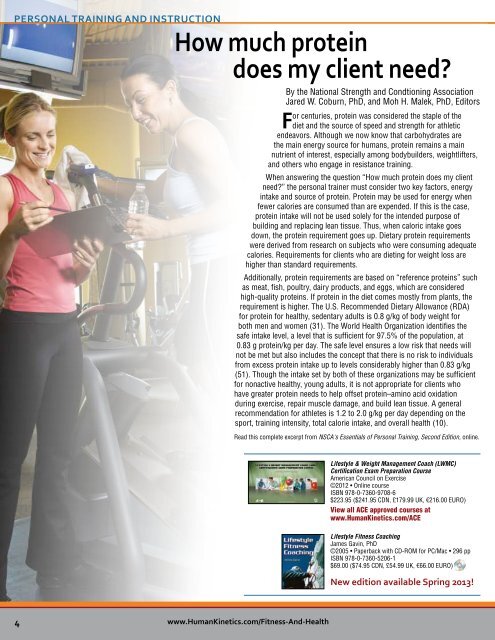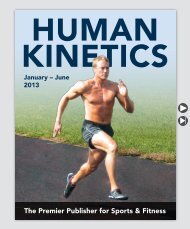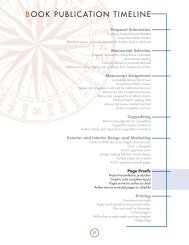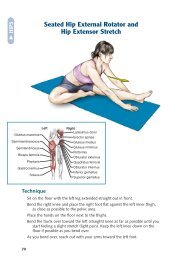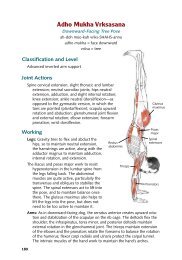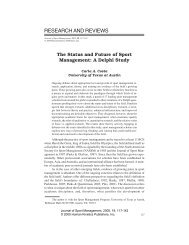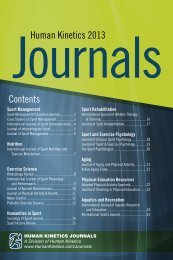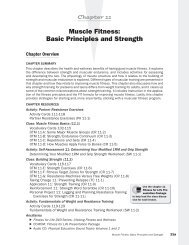PROTEIN PROTEIN - Human Kinetics
PROTEIN PROTEIN - Human Kinetics
PROTEIN PROTEIN - Human Kinetics
Create successful ePaper yourself
Turn your PDF publications into a flip-book with our unique Google optimized e-Paper software.
PERSONAL TRAINING AND INSTRUCTION<br />
How much protein<br />
does my client need<br />
By the National Strength and Condtioning Association<br />
Jared W. Coburn, PhD, and Moh H. Malek, PhD, Editors<br />
For centuries, protein was considered the staple of the<br />
diet and the source of speed and strength for athletic<br />
endeavors. Although we now know that carbohydrates are<br />
the main energy source for humans, protein remains a main<br />
nutrient of interest, especially among bodybuilders, weightlifters,<br />
and others who engage in resistance training.<br />
When answering the question “How much protein does my client<br />
need” the personal trainer must consider two key factors, energy<br />
intake and source of protein. Protein may be used for energy when<br />
fewer calories are consumed than are expended. If this is the case,<br />
protein intake will not be used solely for the intended purpose of<br />
building and replacing lean tissue. Thus, when caloric intake goes<br />
down, the protein requirement goes up. Dietary protein requirements<br />
were derived from research on subjects who were consuming adequate<br />
calories. Requirements for clients who are dieting for weight loss are<br />
higher than standard requirements.<br />
Additionally, protein requirements are based on “reference proteins” such<br />
as meat, fish, poultry, dairy products, and eggs, which are considered<br />
high-quality proteins. If protein in the diet comes mostly from plants, the<br />
requirement is higher. The U.S. Recommended Dietary Allowance (RDA)<br />
for protein for healthy, sedentary adults is 0.8 g/kg of body weight for<br />
both men and women (31). The World Health Organization identifies the<br />
safe intake level, a level that is sufficient for 97.5% of the population, at<br />
0.83 g protein/kg per day. The safe level ensures a low risk that needs will<br />
not be met but also includes the concept that there is no risk to individuals<br />
from excess protein intake up to levels considerably higher than 0.83 g/kg<br />
(51). Though the intake set by both of these organizations may be sufficient<br />
for nonactive healthy, young adults, it is not appropriate for clients who<br />
have greater protein needs to help offset protein–amino acid oxidation<br />
during exercise, repair muscle damage, and build lean tissue. A general<br />
recommendation for athletes is 1.2 to 2.0 g/kg per day depending on the<br />
sport, training intensity, total calorie intake, and overall health (10).<br />
Read this complete excerpt from NSCA's Essentials of Personal Training, Second Edition, online.<br />
Lifestyle & Weight Management Coach (LWMC)<br />
Certification Exam Preparation Course<br />
American Council on Exercise<br />
©2012 • Online course<br />
ISBN 978-0-7360-9708-6<br />
$223.95 ($241.95 CDN, £179.99 UK, €216.00 EURO)<br />
View all ACE approved courses at<br />
www.<strong>Human</strong><strong>Kinetics</strong>.com/ACE<br />
Lifestyle Fitness Coaching<br />
James Gavin, PhD<br />
©2005 • Paperback with CD-ROM for PC/Mac • 296 pp<br />
ISBN 978-0-7360-5206-1<br />
$69.00 ($74.95 CDN, £54.99 UK, €66.00 EURO)<br />
New edition available Spring 2013!<br />
4<br />
www.<strong>Human</strong><strong>Kinetics</strong>.com/Fitness-And-Health


